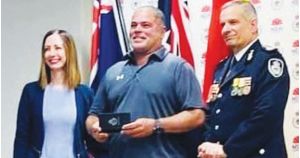By Lachlan Turner
One is simply known as Trigger Plant (Stylidium productum) which flowers from November to January.
Frequently when out walking and looking for any wildflowers it is probable that the bushwalker may notice a small low growing plant with pink flowers on a stem protruding upwards from what appears to be a tuft of fairly thickly leafed grass.
More than likely this plant is one of the Trigger Plants, which are fairly common perennial herbs. There are two very similar varieties of this plant that grow in sandy soils in sheltered locations of open woodland forest.
The other is known as Grass-leaf Trigger Plant (Stylidium graminifolium) which generally flowers from September to December.
These two plants are very difficult to separately identify due to their similarity in growth habit and the colour and form of their flowers. Added to this is their overlapping flowering periods, which make a quick identification difficult.
To explain how the name “Trigger Plant” is derived requires some simple botanical terminology.
There is a small tube in the flower containing the style with two anthers that are usually bent backwards below the flower. An insect lands on the flower’s centre which activates the tube to flick up and strike the insect, thus depositing a layer of pollen on the insect. The insect will visit a neighbouring Trigger Plant and unsuspectingly deposit the pollen onto another flower.
The trigger mechanism usually resets after a short period ready for the next visiting insect.
BROMELIAD SOCIETY OF AUSTRALIA MEETINGS TO BE RESUMED
Great news, for lovers of bromeliads and the Bromeliad Society of Australia is the resumption of their meetings beginning on Saturday, 10 April in the Federation Pavilion, Castle Hill Showground with sales commencing from 10am.

Normal meeting activities such as competitions, Raffle,Show and Tell, and a new activity called just “Show” for people who would just like to share a plant with others without it being critically judged or discussed.
The sales area is still problematic with the 1.5m separation and regular disinfecting of all the frequently touched surfaces.
The way the BSA can make this area safer is to still insist on gloves and masks in this area and the general public accessing the sales area must sign in and abide by the above mentioned rules. Because of the long shut down there are opportunities to purchase some amazing bromeliads that have been stockpiled by many of the local growers.
For further information please contact Ian Hook, President, BSA on mobile 0408 202 269 email: [email protected] or refer to www.bromeliad.org.au

Trees – provide nest sites for mammals, birds, reptiles and frogs and homes for invertebrates. Trees grow flowers containing nectar and produce seeds and fruit which are used as food for birds, invertebrates and mammals.
Trees also provide safe places to hide from predators and provide birds with a perch to check the ground for food. Trees provide hollows, which are used by many animals for homes. In urban and rural areas large, hollow-bearing trees are in decline, but many species of animal rely on tree hollows.
In NSW, hollow-dependent species include at least 46 mammals, 81 birds, 31 reptiles and 16 frogs. Of these, 40 species are listed as threatened with extinction, including the Powerful Owl and Yellow-bellied Glider This is why the loss of hollow-bearing trees has been listed as a key threatening process.
Council is trying to retain large trees with hollows as tree hollows take a long time to form; in some cases they are even creating cut in hollows or installing nest boxes. It is very important to retain habitat trees in your local area. Support the Hollows as Homes project and if you have no large trees on your street try to install nest boxes









